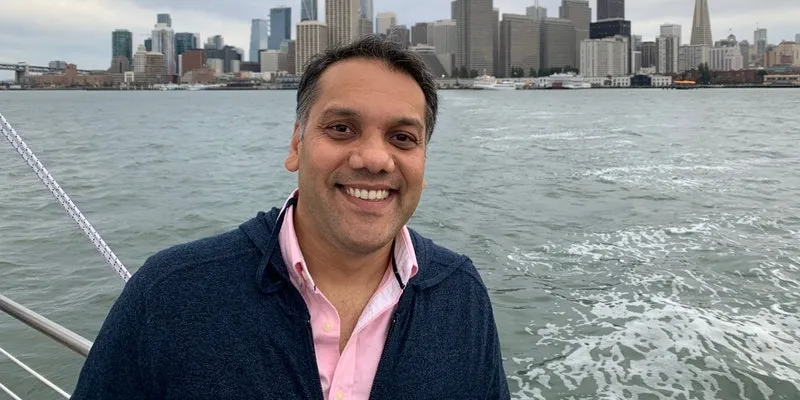[Techie Tuesday] How Anand Jain went from being a door-to-door soap salesman to building Saas startup CleverTap
This week on Techie Tuesday, we feature Anand Jain of CleverTap. He talks about how he learned to code, started his first company when he was 16, and journeyed to the US and back home.
In 2013, when Anand Jain, Sunil Thomas, and Suresh Kondamudi left Network18, they knew one thing: communications in the digital world needed to be timely and quick. This thought led them to start CleverTap, a SaaS-based mobile analytics and mobile marketing company based in Mountain View, California.
Today, as the Chief Strategy Officer and Co-founder of CleverTap, Anand works on larger organisational and strategic goals of helping brands leverage user data, automation, AI/ML, and personalisation techniques on CleverTap. But his tryst with technology began when he was in his early teens.
Born in Lucknow, Anand’s parents moved to Ahmedabad when he was three months old. “I spent most of my childhood and college days in Ahmedabad,” Anand says.
His father worked for the private sector and his mother was a homemaker, but tragedy struck when Anand lost his father when he was 12 years old. His mother set up a small tailoring and boutique operation to support the family.

Anand Jain, Co-founder, CleverTap
The young tinkerer
“I wasn’t very good with academics and I didn’t enjoy it much. In fact, a lot of my time growing up wasn’t spent studying but doing random things. I kept tinkering a lot. I would open up the iron box, refrigerator, TV, and try to put them back together. I learnt how to repair electronics like VCR, cordless phones, and calculators,” he recalls.
Anand decided to study commerce, but began tinkering with computers. He started by assembling PCs and, at 14, wrote his first program, a commercial software for advocates.
“During my teens, I would make things that were not just fun but also made money. It not only helped bring income home but also helped me get my first PC in 1991, when I was in Class 11. My first interaction with the computer was ZX80 and Commodore 64. They didn’t even look like conventional computers; you had to connect the keyboard to the screen,” Anand says. He went on to write different codes and experiment with programming (games).

Anand Jain in San Francisco
Entrepreneur at 16
By the second year of college, in 1994, Anand and a friend started a company, Compoint Computers.
He describes this time as a “phase of learning and hustle”. He was studying, but also making money by selling different things, including soap door to door. Anand would take a train to Mumbai to buy computer parts, spend the night assembling a computer, and sell it for a profit of Rs 3,000 to Rs 4,000.
“I would get into the Gujarat Mail without a ticket, come to Mumbai, spend time on the pavement and wait for shops to open, negotiate and haggle to buy parts, and take a bus back to Ahmedabad. We ran that venture for two years. I then had a fight with my partner and gave up on the business. We were 20-year-olds, and looking back I think we were just kids,” he recollects.
A sales job leading to web development
After a month, Anand chanced upon an advertisement for an electronic sales person role at Cyber World Technologies, a seven-to-10-person company where the receptionist doubled up as HR.
Since he wasn’t an engineer by education, Anand was shuttled around and wasn’t given the chance to meet the CEO. He persisted and soon got five minutes with the CEO. “In the interview I said ‘please don’t go by my qualification; ask me the interview questions, if I fail then I will walk out," Anand says.
He went on to do better than the candidate who was hired, and joined Cyber World Technologies in 1997. He began as a sales executive, but started writing code in Java, C, and C++. He started with selling modems door to door.
“This was the time that Netscape browsers were in rage and I would go to GIDC and meet industrialists and sell the internet,” Anand says. This, however, was his day job. By night, he would use HTML Pagemaker, and Corel Draw, and build the first websites for the same industrialists; Havmor and Vadilal were among them.

Anand Jain during his early days
Learning to code professionally
It was his need and desire to do something different that got Anand to apply for the Centre for Development for Advanced Computers (CDAC), a national-level exam to learn computers. He was selected in 1998 and moved to Delhi for six months to formally begin learning computer coding with Java, C, C++, and Cobalt.
That same year, he returned to Ahmedabad and began working for Software Frontiers Ltd in Gandhinagar as a senior programmer. He landed the job because of his stint at Cyberworld where, while selling modems and browsers, he met Arvin Babu, a successful Bay Area entrepreneur setting up a project in Ahmedabad. He was the foreign collaborator for Software Frontiers.
“I had shown him some programming work I was doing as a hobby and he ended up taking me to the VP of Software Frontiers. Soon, I became the project lead for all US projects. It was funny really because I was the only commerce guy in the entire company,” Anand says.
Here, he started working on the distributed computed model, which was big in 1998. Anand developed a three-tier discussion thread server using Java and worked on a project to develop an Applet game using Java. He also developed a reusable web-based application with Java, ASP, and Oracle Database. The framework was later reused for a travel consultancy and an insurance company.
Entry into the US
Anand went to the US for an on-site trip in 1999. Soon after that, Arvin started a new company in the Valley. In 2000, Anand went to the US and worked for Brience for three years. He built the mobile processing server (MPS) product that the company was building.
“While it was ahead of its time, the product was fairly successful. But timing was a problem,” Anand says. He had co-architected the IDE framework for the MPS server. The IDE was developed using custom renderers and models for various swing components like JTree, JTable, etc.
Three years later, the company shut shop and, in 2003, Anand joined AT&T Wireless, Seattle, where he built the billing app that would let a subscriber log in and change their billing plan. His next break in 2004 took him to Motorola, where he was a part of the software team.
The world before smartphones
Anand worked on building the screen3 app for the new Moto Razr phone.
“It was the third screen. It was here you could subscribe for a horoscope, get weather alerts, etc. It was a time when phones weren’t smart, and there was no Play Store or App Store,” he says.
A year later, Anand wanted to move back to India. But before he could, he had a stint in China.
“I had learnt Mandarin. I was a commerce graduate and always had to prove myself over other engineering graduates, and would keep trying to learn new things. Mandarin was one of them. So, before I moved back to India, the VP of engineering sent me for a deployment at China Telecom (over 200 million subscribers) in 2006,” Anand recalls.
He found the middle ground after six months, moving back to Ahmedabad, and working at the intersection of Beijing and Delhi hours.

Anand's early days in the US
Seeds of Burrp
“At this time I was ideating on a few things and the idea of Burrp, a restaurant review recommendation platform, came,” Anand says. Burrp, founded in 2005, was India’s first foodtech platform. He founded the company with Deap Ubhi, who he had made friends with during his stay at Marin County, San Francisco.
The team ran bootstrapped Burrp for three years. But they couldn’t attract VC attention.
The Infomedia era
He adds that they built Burrp from a one-bedroom apartment. And many people who came in for jobs thought they were being sent to the US during job interviews.
“We had to educate people on what startups are and sometimes, we even had to talk to their parents. We had to convince the candidate, talk to the family, and wait and watch for three months to see if the person still showed up. But we found our people. We did an authentic and honest job. You play with the hand you are dealt,” Anand says.
Burrp was acquired by Infomedia, which by 2012 merged with Network18. Now a part of the InfoMedia team, Anand built AskMe to take on JustDial.
He says, “We built AskMe with an idea to revitalise the yellow pages; why can’t we bring them online?”
Anand worked on Java, Pearl, PHP, C and C++, Foxpro, GW BASIC, Visual Basic, and other programmes, later working on Money Control, Firstpost, IPN Live, and Web18.

Building CleverTap
It was here that Anand met his future Co-founders Suresh and Sunil. In 2013, the trio quit to start CleverTap.
“We started seeing that as a user the world was getting slightly more complex. We access the same product across different platforms: phone, tablet, and laptop. Another trend was that the user’s attention span was decreasing and brands were not keeping up. So we knew communications needed to be super timely and simpler,” Anand says.
He adds that a lot of brands had begun spending money on user attention but nobody was actually solving for it.
“We thought how could we help retain, engage, and convert users. Can these brands understand the user’s unexpressed and expressed needs, and also anticipate their needs?” says Anand.
CleverTap’s first customer was BookMyShow in 2013. Since then, it has raised $76.5 million in funding, and has Accel Partners and Sequoia Capital as its investors.
The changing nature of technology
Speaking of how technology has evolved, Anand explains,
“Technology by itself follows an exponential curve. TV was not tech; it is analogue in nature but today they’re all embedded with tech. It is embedded in our lives without us realising it. AR/VR, machine learning, and Alexa, they all seem like toys, but they will become mainstream soon.”
While hiring people, Anand looks for two main things: hunger and curiosity. He explains that many people are extremely smart but have lost the hunger.
“They think they know everything, but you always have a lot more to learn. Opening up to the fact that I may not know everything is important. Tech changes rapidly; you need to mutate and evolve, you can’t be static. Curiosity helps you understand and get better. People who are curious about learning grow,” Anand says.
Another important factor is competence. This, he says, need not be a degree, but involves a person’s thought process.
“People have to be humble. My advice to techies is that this is an exciting time. Tech is there everywhere; industries are being disrupted and new things are opening up. Whether you join a company or are an entrepreneur, keep an eye out as things change all the time.”
(Edited by Teja Lele Desai)


![[Techie Tuesday] How Anand Jain went from being a door-to-door soap salesman to building Saas startup CleverTap](https://images.yourstory.com/cs/2/a9efa9c02dd911e9adc52d913c55075e/Techietuesdayanandjain800x4001574068055349png?mode=crop&crop=faces&ar=2%3A1&format=auto&w=1920&q=75)
![[Techie Tuesday] From building OpenTable to heading tech at Hotstar, Akash Saxena says curiosit...](https://images.yourstory.com/cs/2/a9efa9c02dd911e9adc52d913c55075e/akash800X4001570431851640png?fm=png&auto=format&h=100&w=100&crop=entropy&fit=crop)
![[Techie Tuesday] From building a group messaging product on SMS to leading Gojek’s Tech Centre ...](https://images.yourstory.com/cs/2/a9efa9c02dd911e9adc52d913c55075e/SiddhuTechie800x4001569289162804png?fm=png&auto=format&h=100&w=100&crop=entropy&fit=crop)
![[Techie Tuesday] From Microsoft, Facebook, PayPal, Coinbase to Lambda - Namrata Ganatra's journ...](https://images.yourstory.com/cs/2/a9efa9c02dd911e9adc52d913c55075e/Techietuesdayheadshot800x4001571072914201png?fm=png&auto=format&h=100&w=100&crop=entropy&fit=crop)
![[Techie Tuesday] Swapan Rajdev of Haptik, one of the largest conversational AI platforms, has o...](https://images.yourstory.com/cs/2/a9efa9c02dd911e9adc52d913c55075e/Techietuesdayswapan800x4001571654046160png?fm=png&auto=format&h=100&w=100&crop=entropy&fit=crop)
![[Techie Tuesday] Meet Anu Acharya, the woman engineer bringing code and data to the Indian geno...](https://images.yourstory.com/cs/2/a9efa9c02dd911e9adc52d913c55075e/techie800X4001572310805550jpg?fm=png&auto=format&h=100&w=100&crop=entropy&fit=crop)
![[Techie Tuesday] Meet Prashant Malik, the man who co-built Cassandra, the database that powers ...](https://images.yourstory.com/cs/2/a9efa9c02dd911e9adc52d913c55075e/Techietuesdayprashanth1572877594221png?fm=png&auto=format&h=100&w=100&crop=entropy&fit=crop)




